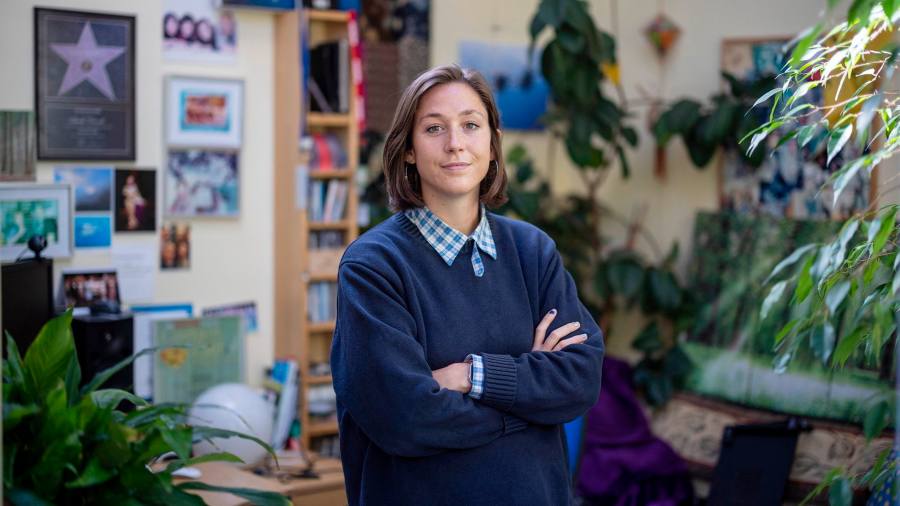
The author is head of the careers service at the University of Oxford and writes the FT’s Dear Jonathan careers advice column
“It’s exhausting, but we love it!” Sharon Soor says about the film and TV industry, where she has recently landed a new job.
Soor, a first assistant production accountant, had previously worked in the music industry, for a car maintenance business and as a film extra. Then one weekend she attended an event run by Screenskills, a non-profit organisation, to show people in mid-career how accounting skills were sought after across media. “After that event, I sent out seven CVs, and got seven replies — eventually choosing to work on The Crown,” she says.
The industry is forecast to grow by up to 36 per cent by 2025, translating to almost 18,700 more production jobs. This growth has created a skills shortage in all “below the line” (ie support) roles. Vicki Goodall, head of production at an independent production company, confirms the skills shortage. “We have never been so busy, the work has never been so good, or so well paid,” she says. “The backlog from the pandemic, plus the rise in commissioning from streaming services, is driving the demand for high-end TV [also known as HETV — defined roughly as costing more than £1mn per episode to make].” Goodall sees a shortage for all skills: “We need lawyers, carpenters, accountants, choreographers, electricians — you name it, there are jobs for everyone.”
The film and TV industry is built on a freelance model. For those with valuable skills and a financial safety net, the lifestyle can be attractive. After her present production, Soor is planning to go travelling for a few months, and feels assured that she’ll get a job the moment she returns. With such flexibility, freelancers are attracted to HETV — especially multi-part series — but less so to documentary, children’s and unscripted shows that pay less well and are shorter assignments.
Goodall observes that it’s a “who you get to know industry”. Once you’ve got in, and worked well with colleagues, the time pressures usually mean that people quickly hire those they’ve worked with before. Esme Ash, a freelance assistant producer, started her career as a BBC production trainee. “I was very fortunate to be on a scheme,” she says, “otherwise you have to start with very ad hoc running work and wait for a break.”
Although successful and in work, Ash says she feels a “constant low-level terror” about securing her next contract. Even on relatively long assignments, contracts are usually month to month. “A few weeks before the end of a contract, I have to organise many coffee meetings, send emails to producers and check the Talent Manager website [a recruitment and networking platform for the TV industry]. So much depends on luck and timing, and when you do land a role, there’s a scrappy hustle with the recruiter about pay rates.”
While Ash doesn’t welcome the “notoriously unsocial hours and lack of holiday” in unscripted television (eg gameshows, talk shows, documentary series), when she meets her old college friends now “working in the City on six-figure salaries,” she notes that “I always have the best stories”. Her love of the creative storytelling, the privilege of meeting people and having an impact overcome the downsides of “filming on the side of a moor at 4am”.
Ben Smith, a freelance production director, also experienced the downsides of “4am in the edit suite”, but adds that the experiences or “moments on set that never leave me” are what keeps him in the industry. The shared challenges that bind the production team, such as “how to get an elephant on a boat”, make the job rewarding.
The “magic allure of storytelling”, as Seetha Kumar, chief executive of Screenskills, describes it, will continue to attract people to work in this fast-growing, quite fragmented industry. The freelance model, based on personal relationships, can appear inaccessible and off-putting to potential workers from under-represented groups. Screenskills works to grow the talent pipeline and show that, as Kumar puts it, “the barriers to entry are not overly complex. Candidates need aptitude, critical-thinking ability and a problem-solving approach. Most things can be learnt on the job.”
Like Soor, who joined the industry in mid-career, Dave Jones is a former Royal Marine who had tried various different roles on leaving the services. Screenskills programmes also appealed to Jones, who is now an assistant unit manager. He likened the work to the positive experience of an operational tour of duty: a team working together towards the same goal for months. In his role, he describes recruiting for a new shoot, “Just two to four weeks before shooting I ask myself, ‘Who do I know who’s available?’”
Growing the workforce and making it more representative requires attracting new people. While schemes help to bring in mid-career production staff, relying on personal networks will not be enough. Added to this, the freelance nature may be unattractive to young people, who often seek more secure roles with supporting benefits that other organisations can provide.
Anna Sinfield, a full-time producer at podcast company Novel, loves the opportunity to make series of 8-12 parts to tell important stories. “It’s very creative and mentally challenging,” she says. “I get the chance to work in many different roles and meet interesting people.” However, she saw that small companies have very limited capacity to train people: “Young assistant producers don’t get a chance now to work on a story.” She built on her own background in radio with extra courses in her own time at weekends.
Perhaps because of the recent growth, the skills shortages, or the fragmented, freelance structure of the industry, there are other pressing issues around working culture. Alex Pumfrey, chief executive of the Film and TV Charity, observes that since the height of the pandemic, workers have become more assertive about other concerns. Pumfrey describes the three pressure points reported in the Looking Glass Survey 2021 on mental health in the film and TV industry. The survey concluded that workers’ mental health suffered from a “culture [of bullying behaviour], conditions [especially unpredictable, long hours] and capability [of managers]”.
The survey reports that conditions have not changed from a similar survey in 2019, although respondents were generally optimistic that things would get better. However, the very people in schools and colleges that the industry seeks to attract, so-called Gen Z, now expect much higher standards of behaviour and conditions than perhaps their predecessors in the industry did.
Pumfrey agrees. “The younger generations are more discerning about industry and employers on [issues such as] mental health support, social justice, racial equality and the climate emergency.” The skills shortage is also driving a “phenomenon of early promotion”, which can lead to poor management practice as people “improvise or impersonate”, as Pumfrey describes it.
A year ago, the Film and TV Charity launched its “Let’s Reset” campaign to improve mental health in the industry. Pumfrey is “really optimistic about the capacity for the industry to change; major employers have been very responsive”. As Ash has observed, perhaps in comparison with her friends in large corporate businesses, “there are no large human resources teams in small production houses, so negotiating contracts can feel scrappy”.
Ash realised that she would have to “speak up” to raise concerns; however, as elsewhere, in an industry that operates on personal networks, reputations can be damaged if poor behaviour is challenged.
While some work to make conditions more attractive, others seek to make it easier to enter the industry. For example, Screenskills recently launched Trainee Finder, a website to match new trainees with opportunities, to make it easier for trainees to enter the industry and producers to bring in new talent.
If the industry wants to become more representative and attract young people, it may find it helpful to make roles more secure, and with more formal training. Relying on goodwill and umbrella industry organisations and campaigns to effect change may not be enough to meet the growth demands.
Ash, Jones and Soor all describe the incredible buzz of working with a team of motivated colleagues towards a single aim. As the industry improves working conditions, it will continue to attract people to Sinfield’s “dream of making perfect stories”.

